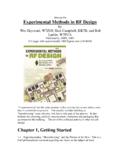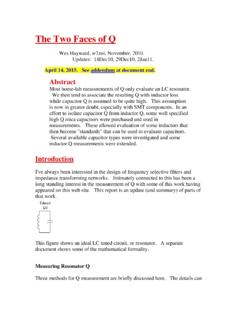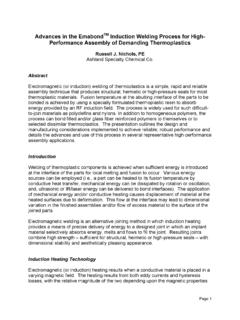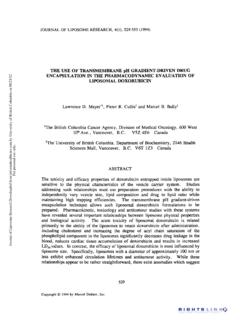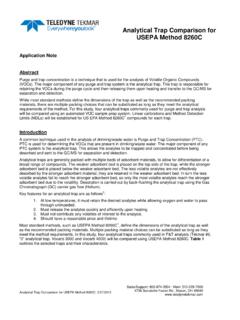Transcription of Pre and postoperative analgesia for orthopedic surgeries*
1 166 Rev Dor. S o Paulo, 2015 jul-sep;16(3):166-70 ABSTRACTBACKGROUND AND OBJECTIVES: Pain is frequent in wards and impairs patients treatment and recovery, especially orthopedic patients. So, this study aimed at evaluating pre and postoperative analgesic adequacy in patients submitted to ortho-pedic surgeries, and at looking for possible variables predicting the analgesic adequacy of such patients in both : This is a quasi-experimental study with two groups, orthopedic pre and postoperative periods, carried out through structured interview, physical evaluation and medical record analysis, in the Surgical Clinic of the Teaching Hospital, School of Medicine, Itajuba/MG, developed with patients in the pre and postoperative periods of orthopedic : Participated in the study 31 patients, all of them with medical prescription of some analgesic drug, being weak opioids those most frequently prescribed in 84% of preoperative cases, increasing to 87% in the postoperative period; 39% had no preoperative pain, decreasing to 36% in the postoperative period.
2 On the other hand, 39% of patients had moderate to severe pain in the preoperative period, increasing to 45% in the postoperative period, being that 74% had analgesic adequacy in the preoperative period, increasing to 81% in the postoperative : Most patients of this study had adequate anal-gesia in the pre and postoperative periods of orthopedic surgery. In our sample, selected variables have not adequately predicted analgesic adequacy in both moments of the orthopedic : analgesia , Orthopedics, Pain, Pain and postoperative analgesia for orthopedic surgeries* analgesia dos per odos pr e p s-operat rio em cirurgias ortop dicasVer nica Ferreira de Aguiar Kawai1, Paulo Jos Oliveira Cortez1, Vitor Engr cia Valenti2, Fernando Rocha Oliveira2, Luciano Magalh es Vitorino3*Received from Teaching Hospital of Itajub , School of Medicine of Itajub , Itajub , MG, Faculdade de Medicina de Itajuba, Hospital Escola de Itajuba, Departamento de ResidenciaMultiprofissional, Itajuba, MG, Universidade Estadual Paulista, Faculdade de Filosofia e Ciencias, Marilia, SP, Universidade Federal de Sao Paulo, Escola Paulista de Enfermagem, Sao Paulo, SP, in December 14, for publication in August 04, of interests: none Sponsoring sources: to.
3 Ver nica Ferreira de Aguiar KawaiHospital Escola de Itajub Rua Miguel Viana, n 42037500-080 Itajub , MG, : Sociedade Brasileira para o Estudo da DorRESUMOJUSTIFICATIVA E OBJETIVOS: A dor comum nas enfer-marias e dificulta o tratamento e a recupera o dos pacientes, principalmente ortop dicos. Assim, o objetivo deste estudo foi avaliar a adequa o da analgesia em pacientes submetidos a ci-rurgias ortop dicas, no pr e p s-operat rio, e verificar poss veis vari veis preditoras da adequa o analg sica desses pacientes nos dois momentos. M TODOS: Trata-se de um estudo quase-experimental com dois grupos, pr e p s-operat rio ortop dico, realizado atrav s de entrevista estruturada, exame f sico e an lise de prontu rio, na Cl nica Cir rgica do Hospital Escola da Faculdade de Medi-cina de Itajub /MG, desenvolvido com pacientes no pr e p s--operat rio de cirurgia ortop dica. RESULTADOS: Foram avaliados 31 pacientes, todos tinham prescri o m dica de algum f rmaco analg sico, sendo o opio-ide fraco o mais prescrito em 84% dos casos no pr -operat rio passando para 87% no p s-operat rio; 39% n o apresentavam dor no pr -operat rio, diminuindo para 36% no p s-operat rio.
4 Por outro lado, 39% dos pacientes apresentaram dor moderada a intensa no pr -operat rio, aumentando para 45% no per odo p s-operat rio, 74% apresentaram adequa o analg sica no pr --operat rio, aumentando para 81% no p s-operat rio. CONCLUS O: A maiorparte dos pacientes desta pesquisa tinha adequa o analg sica no pr e p s-operat rio de cirurgia ortop -dica. Na amostraestudada, as vari veis selecionadas n o apresen-taram predi o da adequa o analg sica nos dois momentos da cirurgia ortop : analgesia , Dor, Mensura o da dor, Ortopedia. INTRODUCTIONPain is defined by the International Association for the Stu-dy of Pain (IASP) as an unpleasant sensory and emotional experience associated to real or potential tissue injury or described in terms of such injury1, which may be acute or chronic, able to leave sequelae and even to be life threate-ning2. Calil & Pimenta3 have reported that after extensive literature review, it was found that pain in emergency situa-tions, such as trauma, is poorly investigated and inadequate-ly treated.
5 In wards, orthopedists and nurses are daily faced with this symptom in the pre and postoperative periods of orthopedic surgeries. In the postoperative period, orthope-dic patients have pain due to trauma-related tissue injury, ORIGINAL ARTICLEDOI and postoperative analgesia for orthopedic surgeriesRev Dor. S o Paulo, 2015 jul-sep;16(3):166-70functional physical activity of the surgery4, lack of pain eva-luation and inadequate use of analgesics5,6. This pain makes difficult patients management and recovery, since there are significant vital signs changes7. A systematic review of factors influencing fast rehabilitation of patients submitted to total hip replacement has identified that patients with postoperative pain had higher incidence of hospital readmission and presentation to urgency , controlling and relieving pain has its humanita-rian aspect and is also a vital part of trauma patients ma-nagement, because they contribute to the maintenance of physiological functions and accelerate the rehabilitation pro-cess3.
6 Pain is a stressor agent for patients, however actions for its better evaluation and management are poorly studied3. It should be evaluated and managed by a multiprofessional team9. Orthopedists and nurses play important role when de-ciding about evaluation, administration of additional analge-sia and maintenance of pain6. When evaluating acute pain it is necessary to investigate location, intensity, onset, duration and periodicity of painful episodes, sensory quality, evolution pattern, worsening or improving factors and other associated symptoms3. Nurses, in their daily lives, evaluate and record patients pain, however, in spite of the availability of strate-gies, they often do not adjust analgesia , ignoring prescribed drugs in an as necessary study by Silva, Pimenta & Cruz10 has shown that ongoing education, both of the medical and the nursing team, had positive effect on pain evaluation and intensity recording, analgesic prescription and patients recovery in the postope-rative period.
7 The visual analog scale (VAS) and verbal des-criptors have been used to plan pain control therapy and to check the adequacy of suggested schedules3,11. VAS is a one--dimension scale of public domain12, provides an estimate of patients pain, is easy to apply and has a score13. After sear-ch in Pubmed/Medline database, with Medical Subject He-adings (MESH) analgesia , pain measurement, orthopedic pain , and combination of Boolean operators AND, OR and NOT , 282 studies with human beings in the last 10 years were found. The same strategy was used for the Scienti-fic Electronic Library Online (Scielo) database, with Health Sciences Descriptors analgesia , pain measurement, orthope-dics, pain however no published study has from such considerations, this study aimed at evaluating analgesic adequacy in patients submitted to orthopedic sur-geries in the pre and postoperative periods, and at observing potential predicting variables of analgesic adequacy for these patients in both was a prospective, quasi-experimental14,15, non rando-mized study with two groups, before and after orthopedic surgery, to collect information about patients management.
8 Participants were admitted to the Surgical Clinic of the Tea-ching Hospital of Itajub , MG (HE-FMIt). Daily visits were carried out looking for patients under surgical treatment of fractures and who would meet inclusion criteria. Interviews and evaluations were carried out between January and August 2014. Tools were a structured questionnaire, physical evalu-ation and medical records analysis. Participated in the study 31 patients aged above 18 years, with Glasgow Coma Scale (GCS) score of 1516 and some type of bone fracture, being surgically treated by the orthopedic on Calil & Pimenta study3, a questionnaire was deve-loped to characterize socio-demographic and clinical profile, in addition to describing pain intensity, use of analgesia and to evaluating the adequacy of analgesia for participants of the study. In the postoperative period, evaluation was carried out 24h after surgery and no longer than 48h later, because ac-cording to Landgraf et , 24h after the procedure residual anesthesia effect has been already eliminated from the following acute pain-related characteristics were evalua-ted: presence or absence of pain; location; intensity in VAS from 0 to 10, quality/type of pain; pain onset; pain dura-tion; worsening and improving factors3.
9 Pharmacological in-terventions were investigated on patients medical records, as to schedule and administration. Analgesic prescriptions were classified as: exclusively analgesics; exclusively non-steroid anti-inflammatory drugs (NSAIDs); weak opioids and strong opioids3. Pain Management Index (PMI) was used to evaluate analgesic adequacy3. PMI aims at analyzing analgesic potency according to patient s referred pain intensity3. Analgesic po-tency (AP) was classified as: 0 no analgesic drug; 1 NSAI-Ds; 2 weak opioid (codeine, tramadol); 3 strong opioid (morphine, meperidine) BioEstat version and Minitab 16 were used for data analysis and calculation of descriptive statistics with mean, standard deviation, absolute and relative frequencies. Anderson Darling test has shown that samples had no nor-mal distribution, so paired Student t test was used to compa-re pain management before and after.
10 Spearman correlation coefficient was also used with the classification: absent or very mild; mild; moderate; severe; and very severe18. Multivariate logistic regression was applied to identify possible predictors of pre and postoperative analgesia . Independent variables were age group, gender, education level, use of alcohol and illicit drugs, type of fracture, fracture segment, reason for the frac-ture, pain evaluation by physician, pain evaluation by nurse, use of analgesics and chronic disease. Outcome variable was analgesic adequacy in both periods. For all tests, p< was considered study was approved by the Research Ethics Committee, School of Medicine of Itajub (FMIt), via Plataforma Brasil under opinion evaluating 31 patients, results are shown in table of socio-demographic characterization of patients (Table 1) have shown that 61% of patients were young/matu-re adults (18 to 49 years old); most (68%) were males, 84% 168 Kawai VF, Cortez PJ, Valenti VE, Oliveira FR and Vitorino LMRev Dor.










